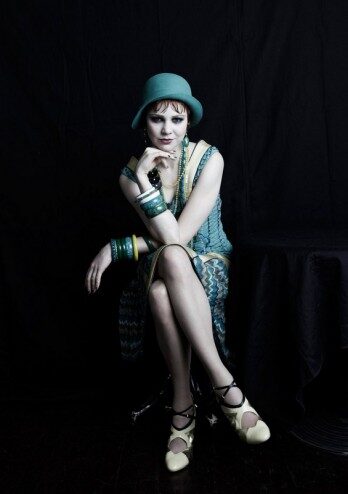Of Money and Sex: Fitzgerald, Luhrmann, and Clothing in The Great Gatsby |
 © 2013, Warner Bros. Pictures 19 Apr ’13
© 2013, Warner Bros. Pictures 19 Apr ’13
Hating Baz Luhrmann’s The Great Gatsby will be easy. Every intermediate reader has read it and loves it and wants to protect it. I’ve read it dozens of times and devoted nearly 20 years to writing about Fitzgerald, his characters, and their clothing. I’ve long imagined Gatsby’s closet, Daisy’s pearls, and Jordan’s knitwear. I know what they look like to me.
What I want to know is: “What do they look like to Baz Luhrmann and costume designer, Catherine Martin?”
F. Scott Fitzgerald’s text goes hand-in-glove with visual interpretation: mascara-laden flappers sobbing as the party ends; a lilac tricorn hat tipped just the right way so you can’t see her eyes; the long strides in white flannel pants across Gatsby’s lawn. There are few examples of complete ensembles in the novel. Creative interpretation is required—interpretation being the key word.
Costume is fundamentally different than fashion. Costume is created. Fashion grows from what sociologist Herbert Blumer called “collective selection”—our modern need to “express new tastes which are emerging in a changing world”(1) Costume is calculated. Fashion is cultivated. Costume is the vision of one person—or team of people, as with the film. Fashion is far more democratic, but it hasn’t always been. It only started to be democratic in the 1920s, that era so artfully captured by Gatsby.
Just don’t be disappointed when Myrtle Wilson does not wear that tight, brown, cotton dress that Fitzgerald masterfully detailed for you. In the film, she has the hair and cleavage of a 1950s pin up. But the detailing of her friends’ cloche hats (felt flowers you can almost feel) will make up for it. Getting caught up on the differences rains on the parade.
For Baz and Fitz, the incarnations of the clothing are different, but the meaning of the clothing is the same. For both, clothing is about two things: money and sex.
Socioeconomic class is inextricable from clothing. My man Malcolm Barnard calls dress “constitutive,” and I like that.(2) Modern readers remember Gatsby’s pink suit because of its connotations with gender. But “pink is for girls” and “blue is for boys” is more of a mid-20th century thing. In its historical context, the colour is about class. It’s about showiness. Until the 1900s, vibrant colours signaled out prostitutes and pimps or associated with post-emancipation African Americans who announced their new-found freedom with display in dress.
In the film, Gatsby’s pink suit is linen and pin-striped, paired with spectator shoes and a gold collar bar. The tapered legs? A tad too much. But the image— an important yet passing reference in the text—is driven home in the film by its contrast to Tom Buchanan’s double-breasted vest in the most ho-hum colour of all: navy blue.
Sex in Luhrmann’s film will be sex, not the “petting parties” that Fitzgerald detailed in Flappers and Philosophers. The shifting sexual mores of American youth are seen in his characters’ clothing. Daisy: bound to a dying social hierarchy; a Victorian in a flapper’s frock. Lilac and lace gloves. In the film, the fitted cut of Daisy’s clothes is almost out of period, but then again, so is she.
Jordan, with her sleeveless dresses and tortoise shell sunglasses, is the new American woman. She is a professional athlete — quite a coup in 1920 — and she makes her living with her body. But not in the same way Daisy does…or Myrtle.
In the book and the film, the clothing of these characters will demonstrate how they get paid. For Fitzgerald, class, sex, and clothing is jumbled and just waiting to be detangled by a thoughtful yet creative interpretation.
If you live and die by historical accuracy, pick apart a period piece on PBS. Or, take the $15 you would have spent on Gatsby, go to a Renaissance fair, and find something to be really mad about.
For this cultural historian and lifelong fan of Fitzgerald, I’ll be sneaking some champers into the midnight showing of The Great Gatsby.
(1) Herbert Blumer, “Fashion: From Class Differentiation to Collective Selection,” The Sociological Quarterly, 10, no. 3, 1969, 275-291.
(2) Malcolm Barnard, Fashion as Communication (New York: 1996).
By Deirdre Clemente
Deirdre is a professor of history at the University of Nevada Las Vegas. She served as a historical consultant to the upcoming film. The twenty minutes she waited in an oversized closet filled with 1920s vintage for a meeting with Catherine Martin were of the best in her life. Her work on Fitzgerald’s use of fashion can be found at fitzgeraldandfashion.com. Follow her on Twitter at FitzFash.
Photographs by Hugh Stewart.
The Great Gatsby is released on 10th May.
© 2013, Contributor.



